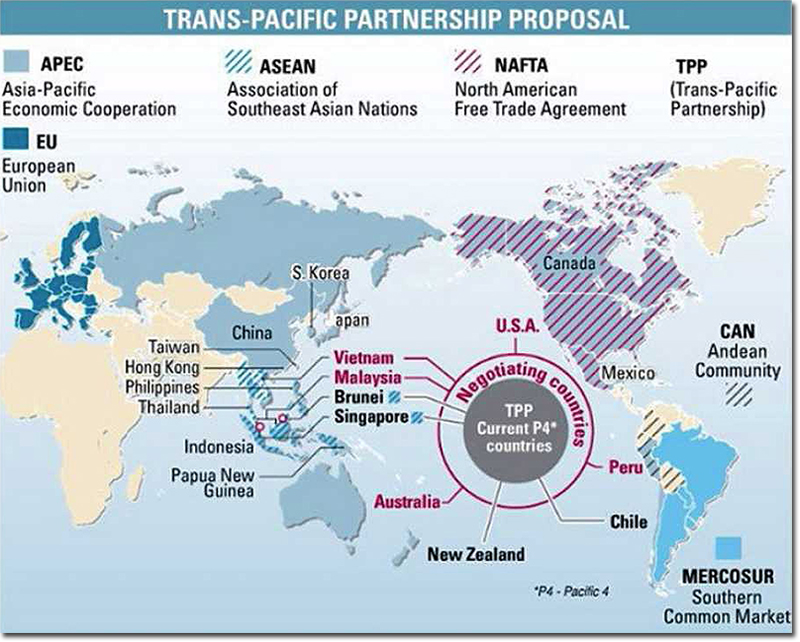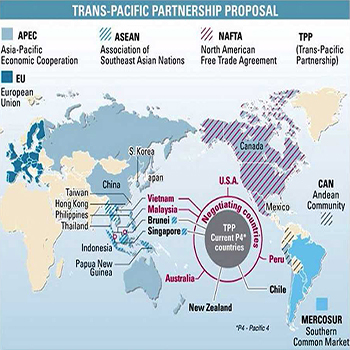NAFTA 20 years later: “2.0” Still Alive for US & Canadian Supply Chain Managers
Nafta at 20 needs Nafta 2.0—a new version of expanded trade and cooperation to help the three member nations better compete with Asia and Europe.
Trade ministers from 12 countries—including the US and Canada—failed to come to agreement at their final meeting in Singapore late last year on the Trans-Pacific Partnership (TPP).
However, the world’s largest economic treaty in history is hardly dead in the water. While many of the proposed terms of the TPP are still shrouded in mystery, there is widespread agreement that the deal has reached a “tipping point” for North American supply chain managers.
Indeed, Canadian and American stakeholders are being urged by trade lobbyists to call on their governments to ensure the agreement includes long-term measures to deal with chokepoints in trade and the supply chain, The most urgent of these is the post-9/11 security measures between the US and Canada border that are impeding the facilitation of goods and services and risking economic security. Other pressing issues include inadequate infrastructure and redundant regulations that have plagued logistics managers for decades.
James D. Philips, President & CEO, Canadian-American Border Trade Alliance, calls the pending deal “NAFTA 2.0” for the fast-growing Asia Pacific Region. As the world’s largest free trade zone, the TPP would give Canada preferential trade and investment access to dynamic new markets. This represents a coveted door of opportunity that may accelerate our hemisphere’s economic recovery.
Philips will be among the speakers sharing market intelligence at the inaugural Cargo Logistics Canada (CLC) Expo in Vancouver on January 29-30, 2014. In an interview with Supply Chain Management Review, he notes that past trade agreements used to deal mostly just with goods, while today’s iteration encompass a broad range of regulatory and legal issues, making them a much more central part of foreign policy and domestic lawmaking.
“Last year, for example, we saw the first-ever joint U.S.-Canada Border Infrastructure Investment Plan (BIIP),” says Phillips. “The development and release of this initiative fulfills a commitment made under the ‘2011 United States-Canada Beyond the Border Action Plan.’”

The BIIP is an interagency and bi-national planning mechanism developed to establish a mutual understanding of recent, ongoing, and potential border infrastructure investments.
It outlines the approach that the US and Canada will take to coordinate plans for physical infrastructure upgrades at small and remote ports of entry. This initiative will be updated and disseminated annually, and follows recent announcements by Canada of significant investments at inland cargo gateways like North Portal, Saskatchewan, which serves Pacific Rim trade.
At the same time, the US and Canada announced a pilot project at the Port of Prince Rupert to eliminate duplicate security checks of marine cargo that enters Canada but is destined for the United States by rail. Under the new approach, cargo is screened only once, at its initial port of arrival, after which it is free to move across the U.S.-Canada border without the need for further inspections – embracing the principle of “screened once, accepted twice.”
As we await the eventual passage of TPP, trade experts maintain that modernization of major West Coast border crossings will reduce wait times, increase reliability of just-in-time shipments, and decrease fuel consumption and greenhouse gas emissions.
In a recent op-ed for the Wall Street Journal Thomas F. Mack McLarty calls for “NAFTA 2.0,” saying North America has lost competitiveness and needs a new boost.
A new era of energy innovation is also rapidly spreading across North America. The U.S. is forecast to pass Saudi Arabia as the world’s top oil producer in 2015. Under President Enrique Peña Nieto, Mexico is implementing reforms that will allow private capital and competition into the state-owned oil industry. Meanwhile, President Obama has set the goal of doubling U.S. exports between 2010 and 2015. On Nov. 8, the president called for billions of infrastructure investment to increase exports.
The U.S. is in negotiations over two major trade initiatives, the Trans-Pacific Partnership, involving 11 countries that include Japan (but not China) and a trans-Atlantic trade pact with Europe. These negotiations are a chance to improve regional competitiveness through convergence of North American regulations, bringing Nafta in line with these new trade initiatives.
Demographic shifts and cultural understanding are making North America more interconnected. The number of Hispanics living in the U.S. has doubled since 1990 to more than 50 million, two-thirds of whom have Mexican heritage. A recent American University poll released in October showed that there remains widespread support among Canadians (80%), Mexicans (74%) and Americans (65%) for regional free trade.
As the U.S. moves through negotiations on new trade pacts, notably the Trans-Pacific Partnership, NAFTA’s legacy surely will play a role.
Meanwhile, President Barack Obama and Canadian Prime Minister Stephen Harper appear to be on the same page when it comes to “version two” of NAFTA – and that can only mean good things for Pacific Rim shippers.
An Alternative View of TPP (from Press for Truth)
The Trans Pacific Partnership - A Corporate Fascist Coup?
(view the video at the top of the page)
There is a bold global corporate takeover happening right before our eyes. The Trans Pacific Partnership has been discussed in secret for nearly 3 years and has been disguised as a trade deal when in reality it amounts to a fascist corporate coup where the megacorporations are gaining a tighter grip over individual governments all over the world.
Sign the “stop the trap” petition
More info on the TPP:
New World Order Blueprint Leaked
Newly Leaked TPP Investment Chapter Contains Special Rights for Corporations
Download the White Paper: North American Free Trade Agreement (NAFTA) Management
Article Topics
Amber Road News & Resources
Logistics Platforms: Ways Companies Can Win In the Digital Era Ethical Sourcing – The Business Imperative (and Advantage) How Rules of Origin Really Do Make a Difference for Sourcing Practices E2open’s acquisition of Amber Road is a done deal E2open Completes Acquisition of Amber Road Bridging the Data Gap Between Sourcing and Logistics Medical Technologies Company Remedies Complex Compliance Operations More Amber RoadLatest in Supply Chain
U.S. Manufacturing is Growing but Employment Not Keeping Pace The Two Most Important Factors in Last-Mile Delivery Most Companies Unprepared For Supply Chain Emergency Microsoft Unveils New AI Innovations For Warehouses Let’s Spend Five Minutes Talking About ... Malaysia Baltimore Bridge Collapse: Impact on Freight Navigating TIm Cook Says Apple Plans to Increase Investments in Vietnam More Supply ChainAbout the Author














